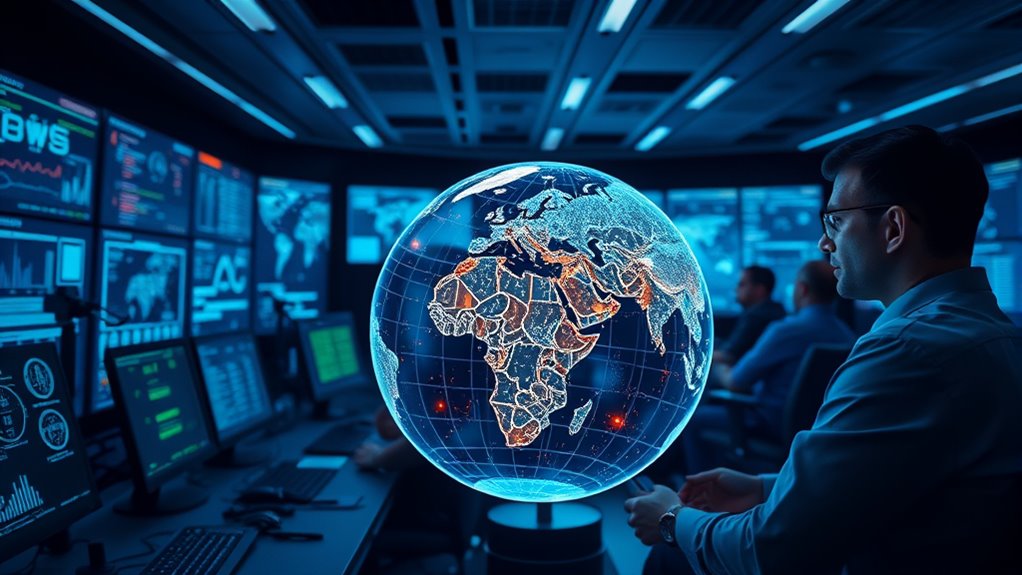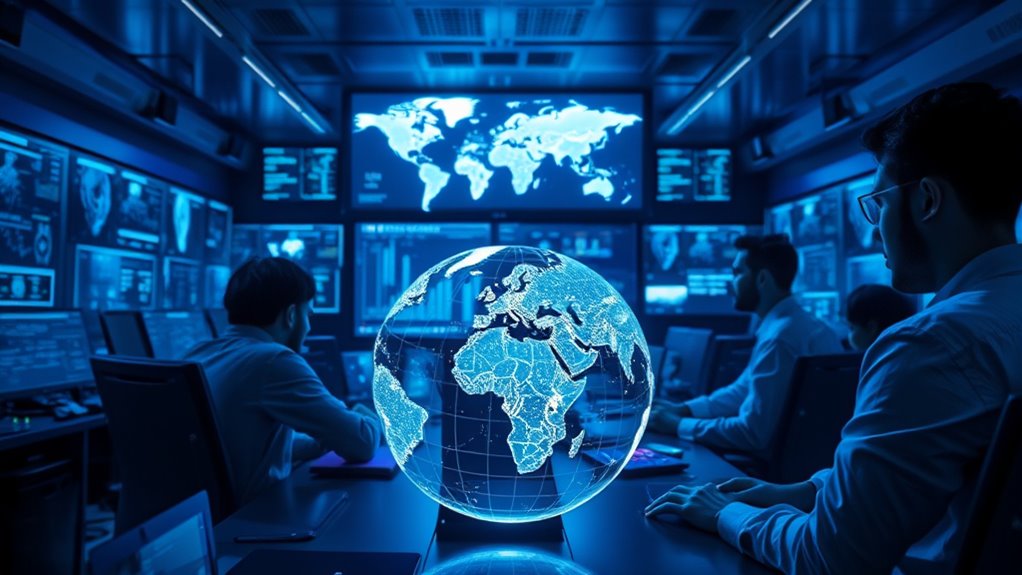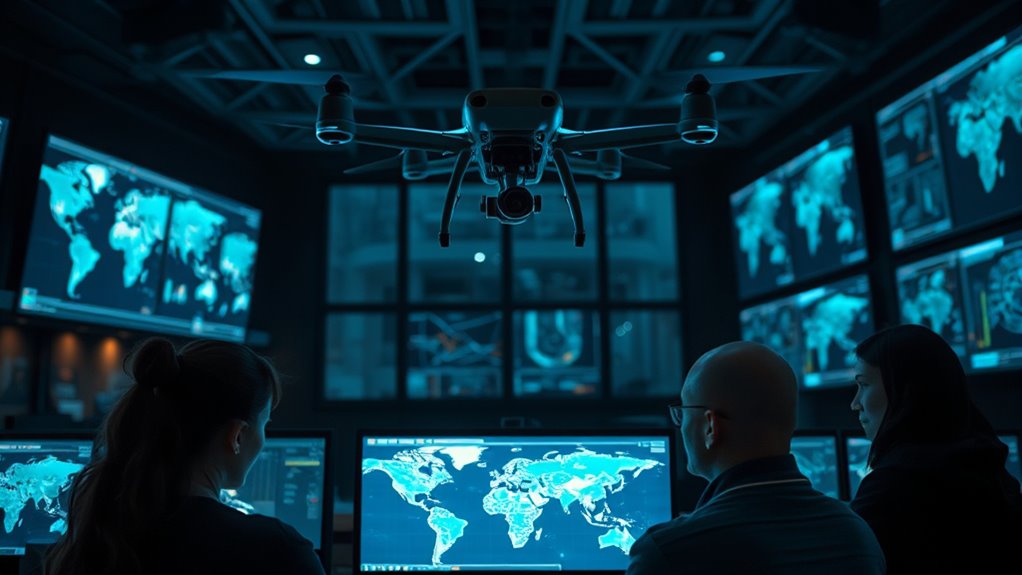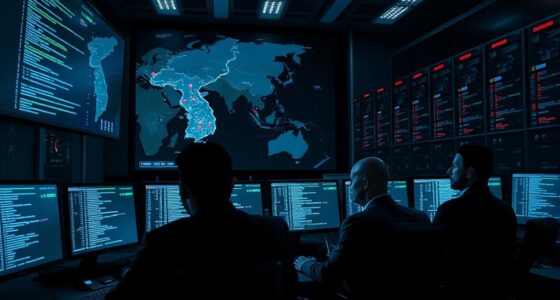France's DGSE leverages advanced AI tactics to enhance national security against global threats. By utilizing AI for intelligence gathering, it speeds up data analysis and improves threat detection. These tools help identify patterns related to cyber espionage and counter-terrorism. Additionally, AI aids in real-time surveillance and monitoring of extremist activities. Collaborating with international partners strengthens these efforts, allowing for a more comprehensive approach. There's much more to discover about how AI shapes DGSE's operations.
Key Takeaways
- The DGSE employs AI to enhance intelligence gathering, improving operational efficiency and accuracy in identifying global threats.
- AI-driven predictive analytics enable the DGSE to forecast potential terrorist activities and proactively mitigate risks.
- Real-time data analysis from surveillance systems helps the DGSE distinguish normal behaviors from suspicious activities, enhancing counter-terrorism efforts.
- The DGSE collaborates with international partners, leveraging shared AI technologies and intelligence to combat global cyber threats and espionage.
- AI supports the protection of critical infrastructure by rapidly detecting and responding to cyber threats in real-time.
The Role of DGSE in National Security

As the backbone of France's national security, the DGSE plays a crucial role in safeguarding the nation against various global threats.
Established in 1982, it operates under the French Ministry of Armed Forces, focusing on intelligence gathering and operations abroad.
With a jurisdiction that includes counter-terrorism, nuclear non-proliferation, and cyber defense, the DGSE's diverse missions are vital in today's complex security landscape.
Its specialized divisions, including the Action Division for clandestine operations, recruit extensively from military special forces.
The agency collaborates with international partners for intelligence sharing, enhancing its effectiveness.
With a budget of about €750 million and a staff of 6,300, the DGSE stands as a formidable force in France's defense strategy, making it one of the leading agencies in telecommunication interception capabilities.
Leveraging AI for Enhanced Intelligence Gathering

The DGSE's mission to safeguard France demands innovative approaches, particularly in how intelligence is gathered and analyzed. By integrating AI technologies, you're enhancing operational efficiency and accuracy in intelligence gathering. AI tools sift through vast data, speeding up analysis and revealing deeper insights. With predictive capabilities, AI identifies potential threats by detecting patterns in data, allowing you to stay ahead of adversaries. This integration aligns with France's historical focus on state-owned enterprises, showcasing the importance of adapting to contemporary challenges. Automation of repetitive tasks frees your personnel to concentrate on high-value operations. Moreover, AI supports decision-making by providing timely, accurate intelligence. In signal intelligence (SIGINT), AI improves detection and analysis, ensuring real-time insights. By leveraging these technologies, you optimize intelligence operations and bolster national security effectively.
Cyber Espionage: The Intersection of AI and National Interests

While nations strive to protect their interests, cyber espionage has become a battleground where artificial intelligence plays a pivotal role.
AI-driven cyber attacks are evolving, making them faster and harder to detect. Nation-states like China, Russia, and North Korea exploit AI for malicious purposes, targeting critical infrastructure to gain geopolitical leverage. The use of advanced persistent threats (APTs) allows these nations to maintain prolonged intrusions, stealing valuable intellectual property. As AI enhances espionage capabilities by quickly analyzing vast data, governments must develop robust cybersecurity measures to counter these threats. Protecting human rights and civil liberties must also be prioritized as nations respond to these challenges, ensuring that AI governance reflects democratic values.
International cooperation is crucial; without it, combating AI-facilitated cyber espionage will remain an uphill battle for national security.
Counter-Terrorism Strategies Powered by AI

Harnessing the power of artificial intelligence, counter-terrorism strategies are evolving to meet the complex threats of our time. AI enhances surveillance by analyzing vast data from cameras and sensors, efficiently identifying potential threats. With real-time analysis, these systems distinguish normal activities from suspicious behaviors, like unusual border crossings. Predictive analytics forecast threats, enabling proactive measures.
Moreover, AI's ability to analyze data from surveillance cameras allows for the identification of potential threats beyond human capability, thus enhancing overall operational effectiveness. In social media, AI scans millions of posts to flag extremist content and detect individuals at risk of radicalization. It disrupts propaganda networks and generates personalized counter-messaging. In cybersecurity, AI protects critical infrastructure by detecting cyber threats in real-time. Overall, AI empowers agencies to develop effective counter-terrorism strategies while adapting to local cultures and languages, ensuring comprehensive threat identification and response.
Strategic Partnerships and International Cooperation

As nations confront increasingly complex global threats, strategic partnerships and international cooperation become essential in bolstering security efforts.
You'll find that the DGSE collaborates closely with NATO and EU agencies, enhancing global security through shared intelligence and joint operations. By engaging with NATO's Civilian Intelligence Committee, the DGSE supports collective decision-making, while its partnerships with EUROPOL focus on combating terrorism and organized crime. Additionally, the DGSE's involvement in NATO's Civilian Intelligence Committee facilitates enhanced information sharing among allies.
Through multilateral forums and bilateral agreements, the DGSE strengthens its capabilities and addresses evolving threats. Moreover, the agency actively shares intelligence and technology with allies, including the U.S., fostering regional and global partnerships. This collaborative approach not only improves crisis management but also builds the capacity of partner nations to respond effectively to security challenges.
Future Prospects of AI in DGSE Operations

The integration of AI into DGSE operations promises to transform intelligence gathering and operational efficiency significantly. With a 35% adoption rate across France, AI's role is expanding rapidly.
You'll notice that AI enhances data analysis, enabling quicker identification of potential threats while automating tedious tasks, which boosts productivity. France's commitment to AI innovation, evidenced by 81 research centers and hubs like Station F, supports cutting-edge developments.
As DGSE leverages AI for predictive analytics and cybersecurity, it'll optimize resource allocation and strengthen network security. Future projects like Fluidstack's supercomputer could elevate these capabilities even further, making AI an indispensable asset in the fight against global threats while adhering to ethical guidelines and regulatory frameworks.
Frequently Asked Questions
How Does DGSE Ensure the Ethical Use of AI in Operations?
To ensure ethical AI use in operations, you'd focus on transparency and accountability.
You'd implement explainable AI systems, allowing users to understand decisions made by algorithms. Engaging diverse stakeholders helps you design fair systems while conducting regular risk assessments to identify potential biases.
Establishing independent oversight bodies and fostering public engagement ensures compliance with ethical guidelines, ultimately building trust and maintaining a commitment to privacy protection in AI applications.
What Specific AI Technologies Does DGSE Utilize for Intelligence Gathering?
To gather intelligence effectively, you'll find that various AI technologies play a crucial role.
Machine learning helps you recognize patterns in large datasets, while natural language processing enhances your language analysis capabilities.
Predictive analytics forecasts potential threats based on historical data, and deep learning analyzes complex data like images and videos.
Data mining extracts valuable insights, ensuring you stay ahead of emerging challenges and make informed decisions in your operations.
How Does DGSE Protect Its Own AI Systems From Cyber Threats?
Imagine a world where your AI systems are under constant threat.
To protect them, you encrypt sensitive data and implement strict access controls, ensuring only authorized personnel can reach it.
You adopt a zero-trust approach, assuming breaches could happen at any moment.
You monitor for unusual behavior, ready to respond at a moment's notice.
Regular audits and updates keep your defenses sharp, shielding your AI from the unseen dangers lurking in cyberspace.
What Are the Challenges of Integrating AI in Intelligence Operations?
Integrating AI in intelligence operations presents several challenges you need to navigate.
You'll face legacy system compatibility issues, data silos, and a shortage of technical expertise.
Data privacy concerns and governance frameworks are crucial for ethical implementation.
Additionally, managing change and adapting your organizational culture is essential to avoid resistance.
Ensuring strategic alignment with long-term goals and maintaining human oversight in decision-making processes are vital for successful integration.
How Does DGSE Evaluate the Effectiveness of Its AI Strategies?
When evaluating the effectiveness of AI strategies, you focus on performance metrics like accuracy and precision.
You conduct operational tests to see how well these systems perform in real-world situations. You also assess human-machine interactions, ensuring they collaborate effectively.
Continuous monitoring is key to adapting to evolving threats. Moreover, you consider ethical implications and regulatory compliance, ensuring that your AI strategies align with broader mission objectives and resource allocation.
Conclusion
As the DGSE harnesses the power of AI, it's not just about staying ahead of threats; it's about safeguarding our way of life. Imagine a world where technology works hand in hand with human intuition, creating a safer tomorrow for all. By embracing innovative strategies and forging international alliances, the DGSE stands resilient against global dangers. Together, we can ensure that the shadows of uncertainty are met with the bright light of intelligence and security.









